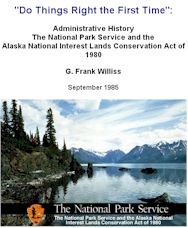
NPS photo Additional informationHistory of the Alaska National Interest Lands Conservation Act (ANILCA) and how Wrangell-St. Elias National Park & Preserve was created: Alaska has been described as the last frontier of the United States. The largest state in the country, Alaska has a land area of 375 million acres and one-third of the coastal shoreline of the Nation. It is a huge state with a tremendous value. Within its borders lie significant natural, scenic, historical, archeological, geological, scientific, wilderness, cultural, recreational, and wildlife resources. The American people faced an enormous challenge when they and their elected officials tried to strike a delicate balance between preservation and development of these resources so that both present and future generations of Americans would be the beneficiaries of Alaska's vast wealth. In keeping with this spirit, the U.S. Congress confronted the longstanding, unresolved issues of native Alaskan land claims, the subsistence lifestyle, energy development, economic growth, and transportation planning by enacting legislative solutions that were intended to be compatible with each other. Among other things, these solutions added to or expanded existing units of the 5 national conservation systems in Alaska -- the National Park System, the National Wildlife Refuge System, the National Wild and Scenic Rivers, System, the National Wilderness Preservation System, and the National Forest System. They also attempted to ensure that the implementation of the Alaska Native Claims Settlement Act (ANSCA) 43 U.S.C. 1601-1629e and the development of Alaska's commerce, its energy resources and transportation systems would be planned for in an orderly fashion. Spanning 3 administrations and 5 sessions of Congress, what had been called the "Alaska lands bill" was enacted into law on December 2, 1980 as the Alaska National Interest Lands Conservation Act (ANILCA) P.L. 96-487. Congress and the administration spent nearly 9 years, from 1971-1980, developing this legislation. As the agency most heavily involved with administering Federal lands, the Department of the Interior was given the responsibility to propose and to implement most of the legislation which would affect the present and, ultimately, determine the future of Alaska. However, a number of different Federal agencies, as well as the State of Alaska, Alaska Native groups, and other interested organizations and individuals were involved in the overall process by which legislative proposals were shaped into law through hearings in the Houses of Congress, and other forms of public participation. The origins of ANILCA date back to the late 1950's when the Territory of Alaska became our 49th state. The Alaska Statehood Act of 1958 authorized the newly established State to select, over time, 104 million acres from the total land area of 375 million acres as an economic base for the new state. On December 18, 1971, Congress passes the Alaska Native Claims Settlement Act (ANSCA) which recognized and settled long-contested rights of Alaska Natives by granting them the right to select approximately 44 million acres of Federal land in Alaska. The Act also afforded the Secretary of the Interior the opportunity to designate new natural, cultural, recreational, and wildlife areas in the Nation. Section 17(d)(2) of ANCSA authorized the Secretary to withdraw 80 million acres of land during the next 2 years to be studied for possible additions to the National Park, national Wildlife Refuge, national Wild and Scenic Rivers, and the National Forest Systems. The deadline for the Secretary's withdrawal action was December 18, 1973. On December 17, 1973, the legislative proposals resulting from these "d-2" studies were submitted to Congress. Following receipt of this legislation, Congress had 5 years, until December 17, 1978, to act. In October 1978, the 95th Congress adjourned without enacting the proposed legislation, although a great deal of progress had been made toward passing a comprehensive Alaska lands bill. The House had successfully passed Alaska legislation on May 19, 1978 by a vote of 277-31. A bill had been reported out of the Senate Energy and natural Resources Committee. Lack of time prevented final passage of an Alaska lands act. In order to prevent the withdrawal status of the lands which were included in the proposed legislation from terminating on December 17, 1978, the Secretary of the Interior on November 16, 1978, exercised his authority under Section 204(e) of the Federal land Policy and Management Act (FLPMA) to withdraw 105 million acres of Federal land in Alaska for a 3 year period expiring on November 19, 1981. The Secretary of Agriculture withdrew and additional 11 million acres under Section 204(b) of FLPMA for a 2 year period. On December 1, 1978, the President withdrew by proclamation, over 55 million acres of Alaskan land and designated them as national monuments, to be administered by the National Park Service, the U.S. Fish and Wildlife Service, and the U.S. Forest Service. The Secretary of Interior, on February 12, 1980, withdrew 40 million acres of land for a period of 20 years under the authority of FLPMA to extend the 3-year withdrawals that were scheduled to expire in November 1981. Finally, in the last days of the 96th Congress, on December 2, 1980, the Alaska National Interest Lands Conservation Act was signed by the President after extensive debate and final passage by Congress. Since then, the following public laws have been passed amending the original legislation: P.L. 97-394, P.L. 97-468, P.L. 98-620, P.L. 99-235, P.L. 99-644, P.L. 100-203, and P.L. 100-241. Additional Resources |
Last updated: January 3, 2020

